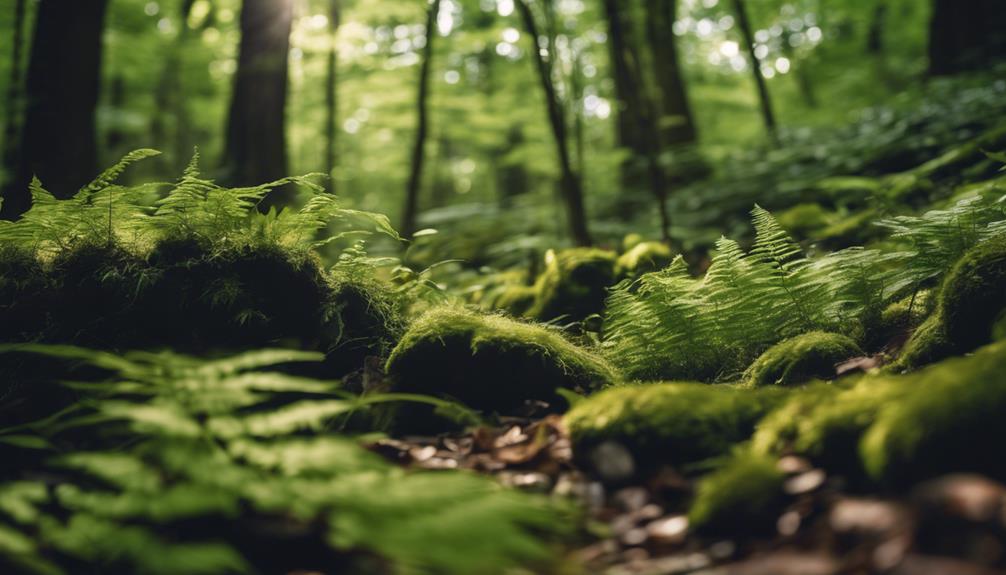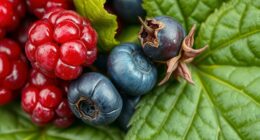To improve your foraging abilities and locate top-notch wild ramps, head to the abundant Appalachian Wilderness, challenging yet rewarding Smoky Mountains, accessible Ozark Mountains, and fertile Great Lakes region. From slow-growth hardwood forests in Appalachia to easily reached ramp locations in the Ozarks, these areas provide perfect settings for your ramp-hunting excursions. Make sure not to overlook the opportunity to explore the Allegheny Mountains in Pennsylvania and West Virginia for quick ramp-hunting getaways. By delving into the hidden corners of these regions, you can come across clusters of ramps just waiting to be harvested. Uncover the prime wild ramp spots and enhance your foraging skills!
Key Takeaways
- Appalachia, Smoky Mountains, and Ozark Mountains are prime locations for abundant wild ramps.
- Great Lakes region, especially around Lake Michigan, offers fertile soil for high-quality ramp growth.
- Allegheny Mountains in Pennsylvania and West Virginia provide easily accessible ramp spots.
- Explore Appalachia's slow-growth hardwood forests and Smoky Mountains' rugged terrain for ramp foraging.
- Equip yourself with essential supplies and a keen eye to uncover wild ramps in these top destinations.
Appalachian Wilderness Foraging
Foraging wild ramps in the Appalachian wilderness offers a thrilling and authentic culinary experience. Ramps, a beloved staple of Appalachian cuisine, grow abundantly in the region, particularly under budding maple trees in ramp patches. The rugged terrain and dense forests of the Appalachians provide a challenging yet rewarding ramp-hunting adventure.
As you venture into the wilderness in search of wild ramps, be prepared for an exciting journey filled with the sights and sounds of nature.
To start your ramp foraging expedition, equip yourself with sturdy boots, a sharp knife, and a keen eye for spotting the distinctive broad leaves and pungent aroma of ramps. Explore the nooks and crannies of the forest, keeping an eye out for clusters of ramps nestled among the undergrowth. Remember to tread lightly and harvest ramps responsibly, ensuring the sustainability of this wild delicacy for future foragers.
Embark on your ramp-hunting escapade in the Appalachian wilderness, where each discovery of a ramp patch brings you closer to a delectable culinary delight.
Scouting Ramps in Smoky Mountains

Scout the rugged terrain of the Smoky Mountains for a challenging ramp-hunting experience. The Smoky Mountains offer ramp foragers an exciting opportunity to explore their foraging skills amidst the diverse wilderness. With numerous hiking trails weaving through the mountains, you can lace up your hiking boots and set out on a rewarding ramp-foraging expedition. For the best results, head to the higher elevations where ramps thrive abundantly.
Navigating the Smoky Mountains for ramps requires preparation and perseverance. Make sure you pack plenty of water and essential supplies to sustain you on your quest. The rugged terrain may pose challenges, but the sense of accomplishment from finding these wild edibles makes it all worthwhile.
Ozark Treasures: Wild Ramps

Exploring the Ozark Mountains yields plentiful opportunities for discovering wild ramps, renowned for their accessibility and abundance in this region.
The Ozark Mountains, stretching from Missouri to Arkansas, offer a rich flora, making them a prime location for ramp foraging.
Ramps in the Ozarks are easily accessible, with many spots reachable by car, perfect for a quick ramp-hunting trip.
The variety of plant life in the Ozarks provides an ideal setting for a day trip to find wild ramps.
Novice foragers will find the Ozark Mountains to be a great spot to explore and harvest these wild delicacies, as ramps thrive in this region.
Whether you're a seasoned forager or new to the practice, the Ozarks offer accessible areas and abundant wild ramps waiting to be discovered.
Great Lakes Ramps Exploration

The Great Lakes region boasts a reputation for providing fertile soil and ideal conditions for the abundant growth of wild ramps. Areas around Lake Michigan are particularly renowned for producing some of the best quality wild ramps in the region.
Exploring the Great Lakes region for wild ramps can be a rewarding experience, but it may require research and planning due to the tricky terrain.
Foraging in the Great Lakes region offers a wonderful opportunity for exploration and discovery. While not as mountainous as other locations, this area is highly regarded for its high-quality wild ramps.
Experienced foragers often flock to the Great Lakes region to seek out these culinary treasures and explore the local areas. If you're looking to enhance your foraging skills and investigate the world of wild ramps, the Great Lakes region is definitely a prime spot to contemplate for your next adventure.
Allegheny Mountain Foraging Spots

In the Allegheny Mountains, you'll discover prime foraging spots abundant with wild ramps, mainly situated in Pennsylvania and West Virginia. These regions offer dense forests that provide ideal shelter for wild ramps to thrive and grow abundantly. The Allegheny Mountains are known for their rich variety of flora and fauna, making them a prime location for ramp foragers seeking a bountiful harvest. The favorable growing conditions in this area guarantee that foraging in the Allegheny Mountains can yield an excellent haul of wild ramps.
Easy-to-reach foraging spots in the Allegheny Mountains make it perfect for quick ramp-hunting trips, allowing foragers to enjoy the beauty of the surrounding nature while collecting their bounty. Pennsylvania and West Virginia boast some of the best locations for wild ramps, attracting foragers with their abundance and accessibility.
Insider Tips for Ramp Discoveries

To enhance your ramp discoveries, focus on seasonal ramp hotspots and master expert foraging techniques.
By honing your skills during peak seasons, you can maximize your chances of finding these elusive wild edibles.
Stay tuned for practical insights and strategies that will elevate your ramp foraging game to the next level.
Seasonal Ramp Hotspots
Discover insider tips for uncovering seasonal ramp hotspots in the Appalachian region and beyond. When hunting for ramps in the Eastern United States, focus on these key areas for the best results:
- Great Smoky Mountains:
For a challenging but rewarding ramp-hunting adventure, head to the rugged terrain and high elevations of the Great Smoky Mountains. Here, you'll find an abundance of wild edibles, including ramps, amidst the stunning natural beauty of the region.
- Ozark Mountains:
Explore the Ozark Mountains, which stretch from Missouri to Arkansas, for accessible ramp-hunting spots. The diverse landscape and fertile areas make it a prime location to discover these flavorful wild onions.
- Allegheny Mountains:
For easy access to dense forests teeming with wild ramps, venture into the Allegheny Mountains in Pennsylvania and West Virginia. These areas offer ideal conditions for harvesting ramps and enjoying the bounty of the land.
Expert Foraging Techniques
Explore secretive techniques utilized by seasoned foragers to unearth elusive wild ramps in their natural habitats.
When it comes to expert foraging techniques for ramp harvesting, it's important to venture into dense hardwood forests with rich, moist soil near stream banks and ravines. These areas, prevalent in regions like Appalachia and the Great Lakes Region, are prime spots for discovering these delectable edible plants. For a more challenging excursion, consider exploring higher elevations in rugged terrains such as the Ozark Mountains.
Experienced foragers also recommend focusing on accessible locations in the Allegheny Mountains for efficient ramp-hunting trips. Taking the time to research and plan your foraging expeditions can greatly increase your chances of stumbling upon these sought-after wild edibles.
Best Locations for Ramp Foraging

Where can you find the best locations for ramp foraging? Here are some prime spots to explore:
- Appalachia: Spanning from southern New York to northeastern Mississippi, Appalachia offers slow-growth hardwood forests that provide the perfect environment for wild ramps to flourish. The rich soil and diverse terrain make it a haven for foragers looking to find these prized plants.
- Smoky Mountains: With rugged terrain and an array of hiking trails, the Smoky Mountains present a challenging yet rewarding ramp-hunting experience. Higher elevations within this region often yield the best results for ramp foragers willing to navigate the rough landscape.
- Great Lakes Region: Particularly around Lake Michigan, the Great Lakes Region boasts fertile soil that supports the growth of wild ramps. While the terrain can be tricky to navigate, with proper research and planning, foragers can uncover high-quality ramps in this area.
Prime Wild Ramp Harvesting Areas

Prime wild ramp harvesting areas include the Ozark Mountains, the Allegheny Mountains, and the Great Lakes Region.
Appalachia, known for its slow-growth hardwood forests, provides an ideal environment for wild ramps to flourish.
In the Smoky Mountains, the rugged terrain and higher elevations offer a rewarding challenge for ramp foragers, with numerous hiking trails leading to successful foraging spots.
The Ozark Mountains, stretching across Missouri and Arkansas, offer accessible ramp-hunting opportunities, making day trips convenient for enthusiasts.
The Great Lakes Region, particularly around Lake Michigan, boasts fertile soil that supports the growth of some of the best wild ramps, although navigation can be tricky.
Lastly, the Allegheny Mountains, found mainly in Pennsylvania and West Virginia, feature dense forests that make ramp-hunting trips quick and straightforward.
These regions are renowned for their abundance of wild ramps, making them prime locations for foragers seeking a successful harvest.
Top Ramp-Finding Destinations

To discover the best locations for finding wild ramps, consider venturing into these top ramp-finding destinations known for their abundant harvests.
- Appalachia: Known for its slow-growth hardwood forests, Appalachia provides an ideal environment for wild ramps to flourish. The rich soil and temperate climate make it a prime location for ramp foraging enthusiasts.
- Smoky Mountains: Offering a challenging yet rewarding ramp-hunting experience, the rugged terrain and higher elevations in the Smoky Mountains yield the best results for foragers seeking a more adventurous quest.
- Ozark Mountains: Providing accessible ramp-hunting opportunities, the Ozark Mountains offer plenty of spots reachable by car, making it a convenient choice for those looking to gather wild ramps without extensive hiking or trekking.
When planning your next ramp-hunting excursion, consider these top destinations for a fruitful and satisfying foraging experience.
Unveiling Ramp Hotspots

Discover the hidden gems where wild ramps thrive in abundance, waiting to be unearthed by enthusiastic foragers.
When it comes to ramp hotspots, Appalachia stands out for its slow-growth hardwood forests, creating the perfect conditions for wild ramps to flourish. The Smoky Mountains offer a rugged terrain filled with numerous hiking trails, providing a challenging yet rewarding ramp-hunting experience for avid foragers.
On the other hand, the Ozark Mountains, stretching from Missouri to Arkansas, offer more accessible ramp-hunting opportunities compared to other regions.
Don't overlook the Great Lakes Region, especially areas around Lake Michigan, known for producing high-quality wild ramps waiting to be discovered.
Additionally, the Allegheny Mountains, primarily located in Pennsylvania and West Virginia, provide easily reachable spots ideal for quick ramp-hunting trips.
Whether you're a seasoned forager or a beginner looking to explore the world of wild ramps, these hotspots offer diverse and exciting opportunities to connect with nature and unearth these flavorful treasures.
Frequently Asked Questions
Where Is the Best Place to Find Wild Ramps?
For the best place to find wild ramps, head to the Smoky Mountains for a challenging hunt with rewarding results. Explore rugged terrain and hiking trails at higher elevations. You'll uncover the freshest ramps there.
Where Can a Ramp Be Found?
You can find ramps in woodlands, streambanks, and ravines across North America. Look for them in hardwood forests with rich, well-drained soil. They often grow near trout lilies and thrive in partial shade.
How to Spot Wild Ramps?
Spot wild ramps by looking for slender white bulbs with broad leaves and burgundy stems. Rub the leaves for a strong onion-garlic scent. Seek them in moist hardwood forests, shaded stream beds, and forest edges.
What Time of Year Can You Find Ramps?
You can find ramps in early spring, typically emerging in April or May. Their prime harvesting period is brief, so timing is essential. Look in moist hardwood forests or near shaded stream beds for these delicious wild onions.
Conclusion
So, are you ready to take your foraging game to the next level? With the best places to find wild ramps uncovered, you'll be on your way to ramp paradise in no time.
Get out there and explore the Appalachian wilderness, scout the Smoky Mountains, unearth Ozark treasures, and discover the ramp hotspots waiting for you.
Don't miss out on this wild ramp adventure – it's time to ramp up your foraging skills and taste the delicious rewards!










